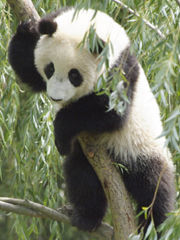|
GIANT PANDA } Ailuropoda melanoleuca

|
RANGE: Confined to south-central China, where it occurs in portions of six isolated mountain ranges (Minshan, Qinling, Qionglai, Liangshan, Daxiangling, and Xiaoxiangling) in Gansu, Shaanxi and Sichuan provinces; about 75 percent of the population is found in Sichuan
STATUS: Internationally Endangered; according to International Union for Conservation of Nature, fewer than 2,500 individuals likely remain in the wild
THREATS: Habitat loss compounded by a low birthrate
Long a poster child for nature protection and for China, the charismatic black-and-white giant panda is one of the world’s most adored creatures. It lives in the mountains of central and southwestern China, where 99 percent of its diet is bamboo — despite the fact that the panda, which is in the bear family, is classified as a carnivore. In ancient China, pandas were often regarded as rare and noble; westerners are not believed to have ever seen these animals until the early 20th century, when, in 1916, German zoologist Hugo Weigold purchased a cub. In the 1920s, Teddy Roosevelt became the first American to shoot a panda.
|